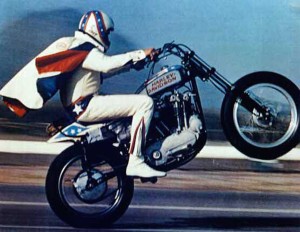
The film was shot using Blackmagic Cinema Cameras, and postproduction was completed using Teranex 2D Processors and DaVinci Resolve.
To capture the colorful life of Knievel, Junge, who won a 2012 Academy Award for best documentary short and a 2012 Emmy for best documentary for his film Saving Face, shot over 60 interviews to compliment a host of rich archival materials. To accomplish this, Junge and the film’s producers at HeLo chose to use Blackmagic Cinema Cameras as the main cameras for the production, as well as Teranex 2D Processors for extensive conversions and DaVinci Resolve for color correction.
“With Evel Knievel, most people know his name, but many people do not know his life,” said Junge. “When making this film, we wanted to capture the spirit of Evel in a way that would do him justice. Blackmagic’s products let us bring to life the vision we had for the film and do it in a way that was efficient and within our budget.”
Shot with Blackmagic Cinema Cameras in ProRes, the film’s interviews were done in various locations across the country in greenscreen studios so that compositing on each shot could be done later with archival footage and effects. Each interview was shot from various angles using four Blackmagic Cinema Cameras, which were then composited into a single unique backdrop for the film.
“We needed four cameras with the same high latitude, that could shoot in ProRes and be easily packed up as we scrambled from interview to interview. Most of the shots had multiple composites in them, and we had a large number of different types of environments with each set,” said Junge. “With the Blackmagic cameras, the color space of each was great, and we were able to get beautiful images. The cameras captured a huge amount of information which came right out of the camera ready to use in post. Having four cameras performing at that level and at that price was amazing.”
Once the interviews were captured, newly shot and archival footage going back to the 1950s had to be converted using the Teranex 2D Processor. All footage was sent through the Teranex 2D Processor, where an initial color balance was completed, and then footage was converted to 1080P. Final color correction was done using DaVinci Resolve, which was also used prior to shooting interviews to create LUTs to ensure that all of the interviews had a specific look and feel.
“Every piece of footage we used went through the Teranex. The Teranex was quick and we easily pushed our way through footage no matter what sort of format we were working with. And we got footage in everything from high end digital to Super8 and VHS tapes,” said James Durée, compositor at Milkhaus, which provided postproduction services for the film. “In particular, being able to color balance in the Teranex saved a lot of time down the line and made final color correction with Resolve much more efficient.”





